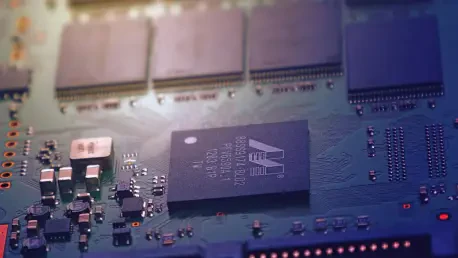Singapore has always stood at the crossroads of technology and innovation, consistently vying for a leading position in global technological advancements. The launch of the National Semiconductor Translation and Innovation Center for Gallium Nitride (NSTIC (GaN)) at one-north is a testament to this ambition. This initiative, valued at $123 million, positions the city-state at the forefront of next-generation semiconductor innovation, particularly in the niche yet burgeoning field of gallium nitride (GaN) wafer production. As a material known for its superior electrical properties, GaN presents promising opportunities tethered to the evolution of 5G, 6G, and satellite technologies. The establishment of such an advanced research and fabrication facility underscores Singapore’s determination to harness these opportunities, ensuring its semiconductor industry remains competitive amidst a rapidly evolving global landscape.
Bridging Technological Gaps
The Promise of Gallium Nitride
Gallium nitride is not just another entrant in the semiconductor world but a groundbreaking development that boasts several advantages over traditional silicon. With its ability to operate efficiently at higher voltages and its reduced heat generation, GaN is ideally suited for next-gen applications. Devices leveraging GaN promise to be more compact and energy-efficient, qualities immensely desired in consumer electronics and burgeoning areas like satellite communications. Singapore’s focus on cultivating expertise in GaN technology aligns well with global trends, as the demand for these advanced devices is expected to markedly increase. The NSTIC (GaN) center aims to capture an expanding market, catering to the projected doubling of the global GaN device market to over US$2.7 billion by 2028.
Such advancements have the potential to redefine multiple industries by enabling faster and more efficient electronic devices. As the digital world leans more heavily on high-speed and sustainable solutions, the role of GaN in delivering these promises becomes more evident. By prioritizing such cutting-edge innovation, Singapore sets its stage not just as a participant but a possible leader in the global semiconductor sphere. The implications of this shift are substantial, not only opening doors for business opportunities locally but also firmly placing Singapore in international discussions around technological solutions and progress.
State-of-the-Art Infrastructure
The NSTIC (GaN) is the first of its kind in Singapore to host both 6-inch GaN-on-Silicon Carbide and 8-inch GaN-on-Silicon wafer fabrication lines. This strategic initiative signifies a bold move to establish leading-edge infrastructure supportive of diverse technological applications. From consumer electronics to the advanced requirements of satellite systems, the facility’s production capabilities are vast. These fabrication lines are essential in bridging the gap between contemporary demands and innovative research, streamlining the process of transitioning theoretical findings into practical applications. Consequently, the NSTIC (GaN) enhances product development cycles, delivering improvements in efficiency and speed-to-market.
The infrastructure investments reflect a broader national strategy to elevate the semiconductor industry. This aligns with concurrent initiatives, such as the development of NSTIC centers focused on other avant-garde domains like Advanced Photonics and R&D Fabrication. By embedding such specialized facilities within its technological framework, Singapore fortifies its position as a competitive leader, reinforcing its innovation-driven economy. These measures also provide a crucial buffer against global supply chain disruptions that have increasingly threatened traditional manufacturing hubs.
Collaborative Ecosystem
Industry Collaboration
The opening of the NSTIC (GaN) represents a pivotal step in supporting and advancing the technological capabilities of local enterprises, especially small and medium-sized enterprises (SMEs) and startups. By offering a local platform equipped with state-of-the-art fabrication infrastructure, the center significantly reduces the monetary barriers that often hinder groundbreaking research and product development. This collaborative approach attracts numerous partners, evident from various agreements signed at the center’s inauguration. For instance, the collaboration with DSO National Laboratories and WaferLead in fabricating high-quality silicon carbide substrates stands out. Through these partnerships, startups can capitalize on the facility’s existing resources instead of investing heavily in their own equipment, thus redirecting capital towards innovation and market expansion.
Such collaborations are instrumental in securing Singapore’s technological future and broadening its reach within global markets. By fostering an integrated ecosystem where ideas and resources are readily shared, Singapore not only secures potential economic benefits but also stimulates a culture of innovation and resilience. This creates an environment where businesses can thrive, adapt, and lead in cutting-edge developments that are crucial for staying relevant in the fast-paced world of technology.
Enhancing Market Competence
Apart from individual collaborations, NSTIC (GaN) plays a crucial role in improving national market competence. The center’s offering of shared resources levels the playing field for local companies, reinforcing their competitiveness internationally. With WaferLead projecting capital savings between $6-$10 million by leveraging NSTIC (GaN)’s infrastructure, it’s evident that shared facilities can facilitate substantial cost reductions and operational efficiencies. These savings permit local businesses to enhance their strategic positioning within their respective markets, allowing more focus on product innovation and customer engagement.
Moreover, such infrastructural sharing acts as a catalyst for talent development within Singapore, equipping engineers, researchers, and academics with practical experiences in fabricating next-gen semiconductor devices. As the nation invests in nurturing a technically adept workforce, it ensures that the local industry remains agile and capable of responding to global demands. This dynamic not only aids in capturing a larger share of the semiconductor market but also solidifies Singapore’s reputation as a stronghold of innovation and technological prowess.
Emerging as a Global Leader
Strategic Positioning
Singapore’s investment in NSTIC (GaN) reflects more than a commitment to semiconductors; it’s an ambitious stride towards owning a stake in the future of global technology markets. As the semiconductor industry pivots towards materials like GaN, the nation’s ability to preemptively develop infrastructure and expertise becomes an undeniable asset. This foresight serves as a strategic advantage when engaging with international competitors and collaborators. Positioned at the crossroads of commerce and innovation, Singapore is uniquely equipped to influence the next wave of semiconductor technologies while simultaneously benefiting from them. The global standard could increasingly be shaped by the advancements pioneered within its shores.
A stellar semiconductor sector also provides a multi-dimensional boost to the economy—driving job creation, attracting foreign investment, and fostering technological spillovers to other industries. The resultant ecosystem benefits extend beyond immediate financial returns, embedding long-term resilience and sustainable growth trajectories within the national economy. This mature approach not only fortifies existing ties with key partners but cultivates new alliances with emerging players in the global landscape, continually renewing Singapore’s relevance and influence across technological advances.
Future-Proofing with Innovation
Gallium nitride (GaN) isn’t just another semiconductor; it’s a revolutionary advancement with many benefits over traditional silicon. Its efficiency at higher voltages and reduced heat generation make GaN ideal for next-generation applications. GaN-based devices promise compactness and energy efficiency, attributes highly sought in consumer electronics and rapidly growing fields like satellite communications. Singapore’s commitment to developing expertise in GaN technology aligns with global trends, as the demand for such advanced devices is anticipated to rise significantly. The NSTIC (GaN) center’s goal is to meet the needs of a burgeoning market, aiming for the global GaN device market to double, reaching over $2.7 billion by 2028.
These innovations could transform various industries by enabling faster, more efficient devices. As the digital era emphasizes speed and sustainability, GaN’s role is increasingly vital. By embracing this cutting-edge tech, Singapore not only positions itself as a player but potentially as a leader in the global semiconductor arena. This shift brings substantial implications, creating local business opportunities and placing Singapore at the heart of global tech discussions.









